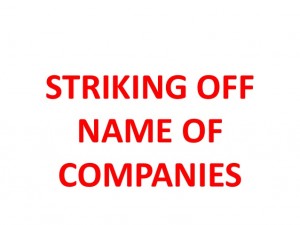In this blog post, Balaji AG, a qualified ACA, ICWA, ACS and CIMA (UK) Industry Consultant and a CFO of a Listed Company for over five years, and who is currently pursuing his Diploma in Entrepreneurship Administration and Business Laws from NUJS, Kolkata, compares the two legal procedures of “striking off ” and “winding up” of a company.
Entities
In India, a business can be conducted under various forms of entities. Most popular forms are a sole proprietorship, partnership, limited liability partnership, companies and co-operative societies. Each of the forms of business has its advantages and disadvantages. The first two forms of businesses from the list above have significant advantages over the remaining forms in the ease of creation and closure. Limited liability partnership, companies, and co-operative societies are entities created under a statute and need to comply with various regulations during its existence. Similarly, closure of these forms of entities can be done only by following the specified procedure under the statutes under which they were created. In our current discussion, we shall focus on closure process of entities which are created under Companies Act.
Companies Act, 2013
In India, companies were incorporated for a long time under the Companies Act, 1956. However, with the introduction of the Companies Act, 2013, companies are now incorporated under the Companies Act, 2013. Being a new legislation which has replaced a well-established statute, the Government has taken a phased approach to the introduction of the new Companies Act. The provisions relating to striking off (Section 248 to Section 252 of Companies Act, 2013) and winding up (Section 270 to Section 365 of Companies Act, 2013) are yet to be notified. Accordingly, the corresponding provisions of the Companies Act, 1956 continues to be applicable
Methods of Closure of Companies
There are various methods under which the companies cease to exist. They can be broadly classified as follows:
- Strike off
- Winding up
Strike off
Striking off a name of the company from the Register of Companies is one of the methods of bringing an end to the existence of the company. Section 560 of Companies Act, 1956 prescribes the law and procedure for striking off the names of defunct companies which are not carrying on any business.
Strike off under Section 560 can be initiated by the Registrar of his motion
Where the Registrar is of the view that a company is not carrying on business or is not in operation, he sends a letter to the company inquiring about the same. If there is no reply within one month, a second letter is sent stating that if no reply is received for the second letter, a notice will be issued in the Official Gazette to (or “intending to”) strike off the name. If there is no reply to the second letter or confirmation that the company is not carrying on business or is not in operation he can proceed to strike off in two steps:
a letter to the company inquiring about the same. If there is no reply within one month, a second letter is sent stating that if no reply is received for the second letter, a notice will be issued in the Official Gazette to (or “intending to”) strike off the name. If there is no reply to the second letter or confirmation that the company is not carrying on business or is not in operation he can proceed to strike off in two steps:
- Send a notice to be published in the Official Gazette that the company would be dissolved at the end of 3 months if there is no cause shown against it. Notice, as mentioned, will be sent by registered post to the Company and Income Tax Authorities.
- Issue a notice to a company under liquidation if he is satisfied that liquidator is not acting, or the affairs of the company are completely wound up, and returns required to be filed by liquidator is not filed for six months. On the expiry of 3 months, the registrar can strike the name of the register and issue a notice in the Official Gazette to that effect.
Strike off under Section 560 on an Application by the Company
- The Company can make an application with the e-form 61 along with necessary attachments as prescribed.
- If the Registrar is satisfied with the correctness of the application, he may proceed to strike off the name and publish a notice in the Official Gazette to that effect.

Strike off under Section 560 under Fast Track Exit mode w.e.f 3rd July 2011
The Fast Track Exit mode is available if:
- The Company has nil asset and liability.
- The Company has not commenced any business activity or operation since incorporation or is not carrying any business activity or operation for the last one year.
- The FTE mode is not available for certain category of companies like listed companies, delisted companies for non-compliance, Section 25 companies, etc
- The FTE form should be submitted along with necessary attachments as prescribed.
- If the Registrar is satisfied with the correctness of the application, then he shall issue an email to the address mentioned in the form, giving 30 days’ time to show cause why the name should not be struck off the register
- The Registrar shall give the information of companies opting for this method in the MCA Portal and give 30 days’ time for raising an objection.
- After the time limit prescribed, he may proceed to strike off the name and publish the notice in the Official Gazette to that effect.
Companies which meet the following broad requirements can proceed to make an application for Striking off:
- The Company does not have any pending statutory dues.
- There is no litigation/proceedings pending against the Company.
- The Company does not have any assets and liabilities.
- The Company has not been in operation for at least a year.
Winding up
Winding up is a proceeding by means of which the dissolution of a company is brought about and in the course of which its assets are collected and realised and applied in payment of its debts; and when these are satisfied, the remaining amount is applied for returning to its members the sums which they have contributed to the company in accordance with the articles of the Company. – Halsbury’s Laws of England
Voluntary Winding Up by Members/Creditors
- A resolution has to be passed in the General Meeting, and Appointment and the remuneration of the Liquidator have to be fixed.
- A notice has to be issued to the Registrar regarding the appointment of the Liquidator.
- A declaration of solvency has to be filed. If filed, it has to be specified if it is a Member Wind Up or a Creditor Wind Up.
- The report of the Liquidator on the statement of affairs is to be placed at a duly called General Meeting.
- The Liquidator has to send a report within a week of the General Meeting to the Registrar and the Official Liquidator.
- The Company is deemed to be dissolved from the date of the report if the Official Liquidator has no objection.
Compulsory Winding Up or winding up by Tribunal
- Circumstances/Grounds mentioned in Section 433 should exist.
- The Petition is to be filed before the Tribunal by an appropriate person.
- The petition is admitted by the National Company Law Tribunal and winding up commences (Section 441).
- Intimation by the Tribunal to the Official Liquidator (Section 444).
- Filing of Statement of Affairs with the Official Liquidator by the company (Section 454).
- Submission of the preliminary report within six months by the Official Liquidator to the Tribunal (Section 455).
- On satisfaction of the report of the Official Liquidator, Tribunal to initiate dissolution of the company (Section 481).
Circumstances for Compulsory Winding Up
- Default in holding a statutory meeting or filing the statutory report.
- The company did not commence business within a year of its incorporation or suspends its business for a whole year.
- The number of members reduced below the statutory minimum.
- The company is unable to pay its debts.
- Default in filing financials or annual returns for five consecutive years.
- The company has acted against the interest of the state, public order, decency or morality.
- Compromise or arrangement cannot be worked satisfactorily.
- Sick Industrial company.
Comparing Striking Off & Winding Up
On a simple review of the above procedures, one might tend to conclude that there is not much difference between the two process in achieving closure of the company. Both have a set of formalities to be complied with. However, in reality, there is a vast difference between striking off and winding up. The process of winding up is quite slow, and it takes more than 25 years on an average to complete the process in eastern regions as per the Eradi committee. 
The striking off procedure is lot simpler and faster compared to winding up. However, it is possible to follow this route only in case of defunct companies. Striking off is the preferred option for defunct companies or companies with nil or very limited liabilities. There are companies which need to wind up its affairs simply because they no longer need to exist. Winding up is also required when companies have assets and liabilities. Further, a liquidator is appointed on commencement of the process of winding up, and he takes full control of the company. He is responsible for collecting/realising the assets, settle the liabilities and distribute the surplus.
The striking off procedure is less expensive as compared to winding up. In the case of winding up, there are fees incurred in respect of the liquidator, the court/tribunal fees, etc.
Conclusion
If a company has stopped operating, striking off is a preferable option to achieve closure given the simplicity of the procedure, the limited time taken and being less expensive. However, to be eligible for this process, the company needs to pay off all its liabilities and statutory dues and not have any pending litigation/proceedings. This may not be possible in case of many companies which have stopped operations. Companies mostly stop operations because they are not profitable, and their net worth is eroded fully or significantly. In such situations, the companies need to follow the winding up route. The Ministry issued a circular in July 2011 to expedite winding up proceedings. The procedure under the new act should be made simpler and effective taking into consideration the size and nature of the company.
[divider]
Acknowledgements
- Companies Act 1956/2013
- MCA Portal
- ICSI Web Modules
- iPleaders Blog – Ms. Pavitra
- Article of Vinod Kothari and Nidhi Ladha – The Faster way to corporate death
 Serato DJ Crack 2025Serato DJ PRO Crack
Serato DJ Crack 2025Serato DJ PRO Crack













 Allow notifications
Allow notifications



